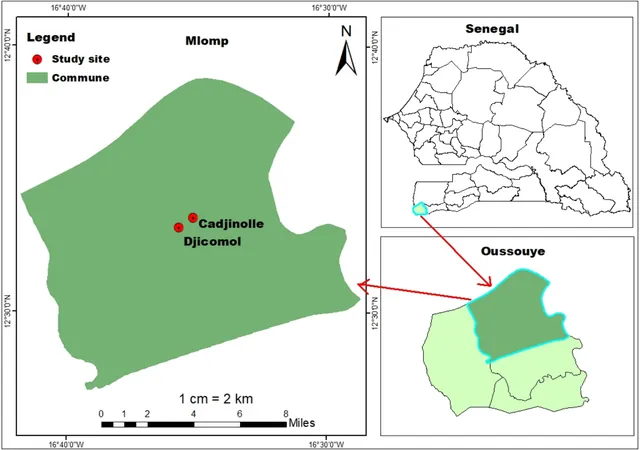
Inside the World of Anopheles gambiae: Uncovering Malaria Transmission Patterns in Senegal’s Pre-Elimination Zone
2025-07-04
Author: Siti
Malaria: A Persistent Global Menace
Malaria continues to plague the world, with a staggering 247 million reported cases in 2021 alone, resulting in 619,000 deaths. Sub-Saharan Africa bears the brunt of this crisis, tallying 234 million cases and 593,000 deaths. In Senegal, the malaria mosaic is diverse, where in 2022, 358,033 cases and 273 deaths were recorded. The incidence has fluctuated, moving from 2.67% in 2020 to 3.12% in 2021, before dipping again to 2.02% in 2022.
Understanding the Complex Interaction of Environment and Vectors
Malaria transmission is predominantly influenced by environmental factors and the dynamics between mosquito vectors and the malaria parasite. In Senegal, various ecological zones correlate closely with the density of these disease-spreading mosquitoes. Notably, the Sudanian zone, with its distinctive bioclimatic attributes, fosters an upsurge in mosquito populations during the rainy season. Waterways, mangrove swamps, and rice fields add to the local transmission landscape by creating favorable conditions for mosquitoes.
Within this context, species from the Anopheles gambiae complex are recognized as the most effective malaria vectors, playing a pivotal role in the transmission of malaria throughout Senegal.
From High Infection Rates to Promising Declines
Back in the early 90s, the southeastern region of Senegal, particularly Mlomp, echoed alarm with entomological surveys revealing around 30 infective bites per person per year. However, thanks to an extensive rollout of vector control strategies like indoor residual spraying (IRS) and long-lasting insecticidal nets (LLINs), the malaria burden has seen a sharp decline. The region is now primed for malaria elimination, but ongoing adaptations in vector behavior stemming from factors like vegetation and livestock presence remain crucial to monitoring.
A Closer Look at the Study in Mlomp
This riveting study, conducted between July 2020 and February 2021 in Mlomp’s Djicomol and Cadjinolle neighborhoods, aims to unravel the entomological parameters of malaria transmission, particularly focusing on the An. gambiae species. Mlomp, a village located in south-western Senegal, features a hot and humid climate with significant rainfall, nurturing an ecosystem ripe for mosquito breeding.
Mosquito Capture Techniques and Findings
The team employed Human Landing Catches (HLC) and Pyrethrum Spray Catches (PSC) over several capture sessions to accumulate data on mosquito populations. Notably, a total of 6,997 Anopheles mosquitoes were collected, with the An. gambiae complex comprising a whopping 99.41%. PCR tests found Anopheles gambiae to be the dominant species, heralding concerning implications for malaria transmission potential.
Transmission Patterns: Bites and Behavior
The study revealed intriguing patterns in human-biting rates, peaking during the rainy months. Monthly averages showed indoor biting rates at 40.11 bites per person per night, illustrating a pattern of risky mosquito behavior favoring nighttime—aligning with their human hosts' availability.
Despite these high interactions, none of the An.gambiae specimens tested positive for P. falciparum, marking a miraculous zero entomological inoculation rate, suggesting that the transmission dynamics of malaria in this setting are uniquely low.
What Lies Ahead?
With this research shedding light on the dynamics of malaria transmission in Mlomp, it prompts further investigation into the environmental factors at play. The remarkable presence of An. gambiae, coupled with zero detected malaria cases, highlights the necessity for ongoing monitoring in pre-elimination areas. There’s an urgent call to evaluate malaria transmission more broadly across regions with higher incidence rates to better comprehend this relentless disease.
In conclusion, as public health efforts continue to evolve against malaria, this study provides critical insight into how environmental changes and mosquito behaviors might impact the future of malaria elimination in Senegal.


 Brasil (PT)
Brasil (PT)
 Canada (EN)
Canada (EN)
 Chile (ES)
Chile (ES)
 Česko (CS)
Česko (CS)
 대한민국 (KO)
대한민국 (KO)
 España (ES)
España (ES)
 France (FR)
France (FR)
 Hong Kong (EN)
Hong Kong (EN)
 Italia (IT)
Italia (IT)
 日本 (JA)
日本 (JA)
 Magyarország (HU)
Magyarország (HU)
 Norge (NO)
Norge (NO)
 Polska (PL)
Polska (PL)
 Schweiz (DE)
Schweiz (DE)
 Singapore (EN)
Singapore (EN)
 Sverige (SV)
Sverige (SV)
 Suomi (FI)
Suomi (FI)
 Türkiye (TR)
Türkiye (TR)
 الإمارات العربية المتحدة (AR)
الإمارات العربية المتحدة (AR)